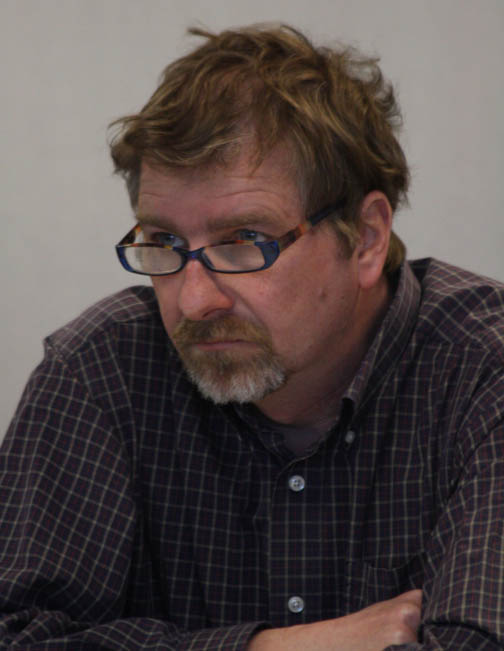Entries in wind developer (65)
3/6/11 Granting the power of Eminent Domain: Will lawmakers give wind developers just what it takes to take what you have?
FROM MONTANA
SENATE COMMITTEE HEARS TESTIMONY ON EMINENT DOMAIN BILL
SOURCE Great Falls Tribune, www.greatfallstribune.com
March 4 2011
KARL PUCKETT,
“They’re cheapskates and a foreign company trying to beat these farmers and ranchers,” said Quick, who said he was representing 10 angry cattle ranchers — eight Republicans and two Democrats — who oppose HB198.
Energy development and private property rights sharply clashed Thursday in a hearing before the Senate Energy and Telecommunications Committee over a bill that would allow developers of “merchant” transmission lines to take private land for the public good.
Testimony over House Bill 198, which had its first hearing in the Senate after previously being approved in the House, lasted more than three hours, with dozens of residents and informational witnesses speaking.
If the bill is passed, “a person” issued a certificate under the Major Facilities Citing Act to build transmission lines or other large infrastructure would have the right to initiate condemnation proceedings.
A decision last year by a Glacier County District Court judge who ruled Toronto-based Tonbridge Power Inc. did not have the authority to use eminent domain prompted the legislation. Tonbridge is building the 215-mile Montana Alberta Tie Line merchant transmission line between Great Falls and Lethbridge, and the ruling stalled the project.
With a merchant line, the developer accepts the risk of the project rather than ratepayers of a public utility, such as NorthWestern Energy. Merchant line developers finance construction by selling shipping rights to the line. In Tonbridge’s case, it sold capacity to wind farm developers who want to ship electricity generated in Montana to bigger markets.
Landowners see the bill as a change in state law for a single company, as well as a general expansion of eminent domain powers.
“This is just a sweetheart deal for a Canadian company, and allows them to condemn Montana farmland for their own use — and that’s just absolutely wrong,” said Larry Martin, a farmer from Conrad who owns land in path of MATL.
John Alke, an attorney representing Tonbridge and Montana Dakota Utilities, said the Glacier County judge’s ruling was only the second time a Montana court applied an “entity specific” standard to prevent an out-of-state developer from using eminent domain.
The first time, in 1907, the Legislature quickly passed a law ensuring a company’s eminent domain powers in building Hauser Dam, he said.
What matters in determining whether an entity has eminent domain power, Alke said, is whether the project benefits the public, not the type of entity doing the work.
If HB198 does not pass, “my client, MATL, is in serious trouble,” Alke said.
“It is in the middle of construction,” he said. “It has crews in the field.”
Derek Moretz, with wind farm developer NaturEner, said his company’s proposed $700 million Rim Rock Wind Farm in Glacier and Toole counties will not be built if MATL is not completed. Any holdup in building the line also could delay the wind farm because federal production tax credits are set to expire in 2012, he said.
“Without this eminent domain tool, we’re just not going to be able to develop these linear infrastructure projects,” said Brett Doney, president of Great Falls Development Authority.
Rep. Ken Peterson, R-Billings, the bill’s sponsor, said the bill doesn’t overhaul the current eminent domain law, but rather clarifies who can use it, including NorthWestern Energy.
Opponents of the bill disagreed with Peterson’s characterization, saying the Legislature never previously granted eminent domain power to a merchant line developer.
“This bill has a narrow motivation with broad affects,” said Beth Kaeding of Bozeman, past chair of the Northern Plains Resource Council.
Lyle Quick traveled to the hearing from Circle in Eastern Montana, where the Keystone XL pipeline is proposed, in order to testify. The line, being developed by TransCanada, would ship oil from Canada to the Gulf Coast, and Quick said HB198 could carry ramifications for that project as well.
“They’re cheapskates and a foreign company trying to beat these farmers and ranchers,” said Quick, who said he was representing 10 angry cattle ranchers — eight Republicans and two Democrats — who oppose HB198.
The Republicans are mad because “we are a party of property rights,” he said. The Democrats are mad because Gov. Brian Schweitzer, also a Democrat, supports the pipeline.
Some residents with land along MATL testified Thursday that they have been treated poorly by Tonbridge in negotiations. They urged lawmakers to vote against HB198.
Residents identifying themselves as tea party representatives, noting the state’s strong property rights protections, also spoke against the legislation. Union representatives spoke in favor of HB198, citing the jobs the projects would create.
Sen. Jim Peterson, R-Buffalo, said supporters of both natural resource development and private property rights are “caught in a vice” as a result of the controversy.
Jim Peterson spoke in favor of the bill, saying shipping electricity out of state is in the public interest, and comparing it to farmers exporting wheat.
“It might not be in Montana, but it is public use just like food is public use,” he said.
Katrina Martin, who lives east of Dutton near the MATL line route, took exception to Jim Peterson’s export comparison during her testimony.
“Yes, I export my wheat,” Martin said. “But I do not get to condemn my neighbor’s property to do it.”
3/3/11 No spin zone, or rather 23% spin zone: Does it matter? Wind turbines make money for investors regardless of energy produced AND Just when you thought nothing they could do would surprise you: Wind developers behaving badly chapter 3,421: How about we charge residents for every complaint they make about our turbines?
Second Feature:
WHO CAN COMPLAIN AND HOW?
PLANNERS STUDY WIND TURBINE ISSUES
March 3, 2011
By Jennifer Linn Hartley
How many complaints a person or a household should be able to lodge cost-free against wind turbines and how those complaints would be dealt with were among the topics the Mason County planning commissioners discussed Wednesday night.
Planning commissioners continued to pore over potential changes to the Mason County Zoning Ordinance in regards to wind turbines Wednesday at the Mason-Lake ISD building, a new location for planning commission meeting due to an anticipated large crowd. More than 75 people attended.
Late last year a group of concerned residents proposed an amendment to the ordinance, requesting more stringent rules for wind turbines in the county.
Consumers Energy has proposed 56 476-foot tall wind turbines in Riverton and Summit townships.
As the Mason County Zoning Ordinance is written now, a complainant must pay for the complaint, and if the wind turbine owner is found to be in violation, then the turbine owner pays and the complainant is reimbursed. The system is designed to guard against nuisance complaints.
Commissioners Wednesday discussed whether the complainant should have to pay to submit a complaint, and, if not, how many complaints each person or household should be allowed.
“The complainant out there shouldn’t have to pay,” said Commissioner Bruce Patterson. “It shouldn’t be up to the person who lives out there in that area to have to pay for the complaint. That’s just wrong.”
Commissioners discussed allowing three complaints from one household before a complainant has to pay. If, on the fourth complaint, the turbine is found to be out of compliance, then the turbine owner pays.
2/22/11 What did wind turbines sound like last night? AND Why are residents upset about new noise rules? AND Wind industry to people and wildlife: Sorry Charlie, but keeping you safe is cost-prohibitive
icing conditions again
we just called the nextera hotline to report that the noise level is high (~55 dba) from the turbines. there is icing conditions out right now and the sound is at a 6 [loudest]. we can hear it from the inside of our home. we hear the repetitive aggressive chopping sound and low droning (rumbling sound).
it sounds as if a highway is just outside our front door. it is disturbing and we feel a heavy air pressure around us. nextera energy says that the sound is virtually undetectable. well, it is detectable. here is a video [ABOVE] just taken from our back porch door tonight. of course the video camera can't give you the heavy air pressure feeling, but you can get a glimpse of the sound. Source
Next Feature:
WHY DID THE COUNTY OF TIPPICANOE AGREE TO RAISE TURBINE NOISE LIMITS WELL ABOVE THOSE RECOMMENDED BY THE WORLD HEALTH ORGANIZATION LIMITS FOR HEALTHFUL SLEEP?
“It was to accommodate the wind turbine people,”
County Commissioner John Knochel
CLICK on image above to see why Tippicanoe County residents are so upset about wind company Invenergy's victory in pushing up wind turbine noise limits. Why 2 of the 3 commissioners voted to protect the wind developers interests over the interests of the residents they represent is unknown.
WIND INDUSTRY WANTS SAFETY LAW CHANGED; GROUP SAYS IT IS TOO COSTLY TO ALTER EXISTING TOWERS
SOURCE: The Argus Leader, www.argusleader.com
By Cody Winchester
A state law designed to protect low-flying aircraft from air hazards could inadvertently hinder efforts to expand South Dakota’s wind industry, a wind-energy advocate said Monday.
“This will severely hurt wind development in South Dakota,” said Steve Wegman, director of the South Dakota Wind Energy Association.
At issue is a year-old statute that requires anemometer towers – known as met towers – to be striped in alternating colors, and to have sleeves and visibility balls mounted on their guy wires. There also are new requirements for perimeter fencing.
The law is meant to protect low-altitude aircraft, mainly crop dusters and helicopter pilots.
The problem with the law, Wegman said, is that existing towers weren’t grandfathered in. As a result, developers who own met towers are being required to take them down and retrofit them, which can cost $5,000 or more – a prohibitively expensive proposition for many.
“Towers are going to come down. They’re not going to go back up,” Wegman said.
Met towers range from 30 to 100 meters tall. They’re used to measure wind speeds before building new projects. They first started popping up in South Dakota in the early 1990s, and the 200 or so that now dot the state are crucial to future development, Wegman said.
“Without good data – collecting data takes anywhere between five to nine years – you can’t get financing,” he said.
Another problem with the law is that visibility balls add weight and collect ice, making tower failures more likely. That possibility has led some met tower manufacturers to stop providing warranties for products that require visibility balls, he said.
Rod Bowar, president of Kennebec Telephone Co., which installs met towers, said he understands the need for the rules but worries it could keep the smaller players out of the wind business.
“And I don’t think that’s probably healthy, long term,” he said.
Add it all up, Wegman said, and it’s one more reason to develop wind projects elsewhere.
But pilots and aviation regulators say the marking rules are necessary to keep pilots safe.
“We think they’re a good thing,” said Bruce Lindholm, program manager for the South Dakota Office of Aeronautics. “They’re helpful for aviation safety.”
John Barney, president of the South Dakota Pilots Association, said his organization isn’t opposed to the towers, but making them more visible “is just common sense.”
“We have lobbied the FAA about making it mandatory that these towers are marked or lit in a way that would not pose a hazard,” he said. “Unfortunately, up to the present, anything under 200 feet in altitude doesn’t fall under current regulations.”
He’s optimistic the FAA will change its policy, pointing to the case of a crop sprayer in California who was killed last month when he clipped a met tower and his plane went down. This is why grandfathering in existing towers simply won’t do, Barney said.
“Quite frankly, those are the towers that are going to kill somebody,” he said.
At the national level, the Federal Aviation Administration has opened a docket to examine the issue.
“When you have a crop duster out there flying in the fields, making steep descents and abrupt turns, seeing one of these pop up out of the middle of nowhere can be a challenge,” FAA spokeswoman Elizabeth Isham Cory said. “We’re very concerned about them,” she added.
Lobbyists for the state wind industry, meanwhile, are pushing House Bill 1128, which would grandfather in existing towers. The original bill was defeated, but lawmakers stripped out the language and created a new bill – a process known as hog housing. The new version passed out of committee Thursday.
NOTE FROM THE BPWI RESEARCH NERD: Just a month ago...
Pilot might not have seen met tower before fatal Delta crash
January 19, 2011
OAKLEY -- A crop duster pilot killed last week may not have seen the weather tower that his plane clipped, causing him to crash on a remote island in the Delta, according to a preliminary report by the National Transportation Safety Board.
Stephen Allen, 58, died in the crash reported about 11 a.m. Jan. 10 on Webb Tract Island, located about two miles north of Bethel Island. Allen was a resident of Courtland, a town about 20 miles south of Sacramento. Continue reading.....
FILE UNDER OTHER THINGS THAT WOULD BE TOO COSTLY TO THE WIND INDUSTRY TO CONSIDER:
Protecting birds...
WIND INDUSTRY GROUP OPPOSES FEDERAL GUIDELINES TO PROTECT BIRDS
The American Wind Energy Association Industry said it will oppose plans by a federal agency to adopt voluntary regulations on wind developers to protect birds and other wildlife.
AWEA said in a release that more than 34,000 MW of potential wind power development, $68 billion in investment and 27,000 jobs are at risk due to U.S. Fish and Wildlife Service policies on golden eagles.
Read entire article: www.pennenergy.com
Allowing moratoriums to give local government time to create ordinances....
HEARING HELD ON WIND TOWERS
"Christopher Phelps, the executive director of environmental advocacy group Environment Connecticut, said the moratorium would send the wrong message to companies like BNE. Along with the Connecticut Fund for the Environment and Environment Northeast, who also spoke at the hearing last Thursday, Mr. Phelps said that his group was opposed to the moratorium.
“One of the core reasons we oppose a moratorium is it would send a chilling message to the wind industry, that Connecticut is not open for business,” he said.
Increasing setbacks to protect property rights....
"It's a death sentence.
This has everything to do with eliminating wind power. That's why the proposal is so high.
It's a hit job."
- Michael Vickerman on increasing setbacks to 1800 feet from property lines
Vickerman is a registered lobbyist for RENEW Wisconsin: "Our modus operandi is to identify barriers to renewable energy development, and come up with strategies for overcoming those problems, whether they be low buyback rates, permitting challenges, or regulatory roadblocks."
RENEW'S clients include whose clients include Alliant Energy, ATC, We Energies, MG&E, North American Hydro, WPPI, Invenergy, Emerging Energies, Michels and many wind developers with projects pending in our state. [SOURCE]
Adopting the World Health Organizations recommendation of 40dbA as top noise limit for healthy sleep...
COUNTY SIGNS OFF ON NOISIER TURBINES:
Accompanied by his two young children, Tippecanoe County resident Robert Brooks issued an emotional plea to the commissioners to protect his family from loud nuisance noise that he worries will disrupt their sleep. After the commissioners voted, Brooks asked them, “How can I sell my house right now? … I don’t know why the ordinance had to change. You’ve given (the developers) a free ticket.”
During the debate at the commissioners meeting, the majority of those in attendance spoke against the changes. As it is now amended, the ordinance allows for large wind turbines to generate an average sound output of 50 decibels per hour.
"....Greg Leuchtmann, development manager for Invenergy’s project, said Monday that the changes to the county’s ordinance are balancing protections for residents with the needs of the developers. (It’s about) what will allow a development and what will cancel a development,” he said.
READ ENTIRE ARTICLE: Journal and Courier, www.jconline.com
More....
MANY UPSET BY TURBINE DECIBEL LIMIT
“My question is, why has this one company so much allowance to come back and ask for changes to a regulation?” Sarah Tyler asked the commissioners.
Commissioner John Knochel voted against the change in decibels.
“It was to accommodate the wind turbine people,” he said.
Invenergy representative Greg Leuchtmann spoke to the commissioners during the meeting.
“We are trying to get to something that is very objective and measurable that will protect residents as well as allow for this project to happen,” he said.
The commissioners got a sound consultant firm’s opinion on the county’s noise amendments.
“Feedback we got from the consultant was mainly negative on the amendments that were being proposed,” Knochel explained. “In other words, he thought they were a little too high.”
READ ENTIRE ARTICLE:WLFI, www.wlfi.com
1/20/11 Wind siting issue back on the floor with Walker's Senate Bill 9 AND What to do about advocates of Big Wind smashing concerned resident's yard signs?
Looming battle over wind turbines
Is Governor Scott Walker picking a fight with the state’s wind energy industry? It may be shaping up that way. The governor wants a second look at the process for placing wind turbines in Wisconsin, citing the concerns of adjoining property owners and businesses. Walker said this week that such concerns “had not been addressed.” The current Public Service Commission rules were finalized in September of 2010, after a nearly year long public process that began with the passage of enabling legislation which drew bipartisan support. “We thought it was more important to address that through the legislative and executive branches,” Walker said.
“The legislature was engaged in this issue for more than two years,” said Keith Reopelle with Wisconsin Environment. “They passed a bill, which like most complex pieces of legislation left the details up to a state agency which actually has expertise in that area.” Reopelle noted that the Public Service Commission held a lengthy series of public hearings in order to develop the rules.
Walker, who emphasized jobs creation during the campaign for governor, and who has called a special legislative session on jobs and the economy, said the intent in changing the setback rules for wind turbines is not to cost the state more jobs. “Certainly, we don’t want to do things that have an economic impact. By the same token, I think for adjoining property owners there’s some serious concerns out there, and we’re trying to balance the two,” the governor said.
Wisconsin Environment’s Reopelle said that changing those rules would “bring to a screeching halt” up to ten projects around the state. And he noted, there jobs at stake, as manufacturers in communities around the state are now producing components for wind turbines.
AUDIO: Bob Hague reports (:60)
READ ALL ABOUT IT! HOT OFF THE PRESS:
CLICK HERE TO DOWNLOAD WALKER'S NEW WIND SITING BILL
WHAT DOES IT SAY?
Under current law, (ACT 40) the Public Service Commission (PSC), with the advice of the wind siting council, must promulgate rules specifying the restrictions that a city, village, town, or county may impose on the installation or use of a “wind energy system,” which is defined as equipment and associated facilities that convert andthen store or transfer wind energy into usable forms of energy.
The restrictions must satisfy certain conditions, including preserving or protecting the public health or safety and not significantly increasing the cost of a wind energy system or significantly decreasing its efficiency.
In addition, the subject matter of the rules must include setback requirements and decommissioning, and may include any of the following:
visual appearance
lighting
electrical connections to the power grid
maximum audible sound levels
shadow flicker
proper means of measuring noise
interference with radio, telephone, or television signals
or other matters.
Current law prohibits a city, village, town, or county from placing a restriction on the installation or use of a wind energy system that is more restrictive than the PSC’s rules.
This bill imposes additional requirements on the PSC’s rules.
The bill requires that, if a PSC rule involves a person who is affected by a wind energy system, including a rule that requires written notice, the rule must ensure that such a person includes an “affected owner,” which the bill defines as the owner of property located within one−half mile of property on which a wind energy system is installed or proposed to be installed.
In addition, the rules must allow an affected owner who has entered into an agreement with an owner or operator of a wind energy system regarding the installation or use of the wind energy system to terminate the agreement upon giving written notice of the termination no later than 10 working days after entering into the agreement.
Also, the rules must require any individual who negotiates an agreement with an affected owner on behalf of an owner or operator regarding an interest in real estate related to the installation or use of a wind energy system to make a written disclosure that the individual is licensed as a real estate broker or is exempt from such licensure.
The rules must also require inclusion of the written disclosure as an addendum to such an agreement.
Additionally, the rules must require an owner or operator to provide a copy of a brochure prepared by the PSC to an affected owner prior to entering into an agreement with the affected owner regarding the installation or use of the wind energy system.
The brochure must describe wind energy systems, requirements under state law applicable to wind energy systems, including any provisions of the PSC’s rules that allow for waiver of any such requirements, and the possible impacts of wind energy systems on property owners, including affected owners.
In addition, the bill eliminates the requirement for the PSC to promulgate rules regarding setback requirements, and requires instead that the owners of certain wind energy systems comply with setback requirements specified in the bill.
The bill’s setback requirements apply to the owner of a “large wind energy system,” which the bill defines as a wind energy system that has a total installed nameplate capacity of more than 300 kilowatts and that consists of individual wind turbines that have an installed nameplate capacity of more than 100 kilowatts.
The bill defines the owner of a large wind energy system as any of the following:
1) a person with a direct ownership interest in such a system, regardless of whether the person was involved
in acquiring the necessary rights, permits, and approvals or otherwise planning for the construction and operation of the system; or
2) a person acting as a developer of a large wind energy system by acquiring the necessary rights, permits, and approvals for or by planning for the construction and operation of the system, regardless of whether the person will own or operate the system.
The foregoing definition is similar to a definition in rules promulgated by the PSC.
Under the bill, the owner of a large wind energy system must design and construct the Under the bill, the owner of a large wind energy system must design and construct the system so that the setback distance is at least 1,800 feet.
However, the bill allows for a setback distance of less than 1,800 feet if the owners of all of the
following agree in writing:
1) properties adjoining the property on which the large wind energy system is located; and
2) properties separated only by a right−of−way from the property on which the large wind energy system is located.
The bill also specifies that setback distance must be measured as a straight line from the vertical center line of the wind turbine tower of the large wind energy system to the nearest point on the property line of the property on which the large wind energy system is located.
This requirement is similar to a requirement in rules promulgated by the PSC.
Current law requires the wind siting council to submit a report to the legislature every five years that describes the following:
1) peer−reviewed scientific research regarding the health impacts of wind energy systems; and
2) state and national regulatory developments regarding the siting of wind energy systems. The report must also include any recommendations for legislation.
The bill requires the wind siting council to study the impacts of wind energy systems on property values and to include the results of its study in the report.
CLICK HERE TO DOWNLOAD THE COMPLETE NEW WIND SITING BILL
SUPPORT SENATE BILL 9: WALKER'S WIND SITING REFORM
Better Plan encourages you to take a moment right now to contact Governor Walker's office to thank him for including these more protective requirements in this bill and to also contact your senator and representative to encourage them to support it.
CONTACT Governor Scott Walker govgeneral@wisconsin.gov
115 East Capitol
Madison WI 53702
(608) 266-1212
CONTACT Legislators
Who Are My Legislators? To find out, CLICK HERE
Senate | Members | E-Mail Directory
Assembly | Members | E-Mail Directory
SAMPLE LETTER TO A SENATOR FROM A RESIDENT OF ROCK COUNTY
Dear Senator Cullen,
I’m writing to ask you to support Senate Bill 9, concerning wind siting issues in our state.
Five Towns in Rock County lawfully passed wind siting ordinances which were overturned by Act 40 — legislation which stripped local government of the power to regulate wind energy systems in their communities.Other towns in your district were also considering wind ordinances before Act 40 took away that right.
Rock County Towns with lawfully adopted ordinances include
Town of Janesville,
Town of Center,
Town of Spring ValleyTown of Magnolia
Town of Union
The ordinances were a product of over a years worth of work and expense. All four towns would like to see their ordinances restored, all of them call for a health and safety setback of 2640 feet from homes unless a homeowner agrees to have a turbine closer and also a more protective turbine noise limit than that provided by the state.
Although Governor Walker’s bill doesn’t address these health and safety issues directly, his bill does help to protect property rights and certainly provides greater setback protection than the PSC’s wind-developer-friendly guidelines.
This bill is also clear about allowing individual homeowners the choice to have turbines closer to their property line if they wish to enter into an agreement with the developer.
The jobs that wind farms will bring to Wisconsin are for the most part short-term construction jobs which are frequently done by construction workers called in from out of state. After the turbines are up, the jobs that remain are few.
Many Wisconsin residents now living in wind projects desperately want to move away because of turbines sited too close to their residences, but cannot sell their homes because few buyers want to live so close to turbines that are 40 to 50 stories tall.Current PSC setbacks are just too close to homes. Wind project residents sleep is disrupted because of nighttime turbine noise. TV, radio and cell phone reception has been disrupted by the turbines as well.
Although not perfect, Governor Walker’s bill is an important step toward protecting Wisconsin residents by requiring more responsible siting guidelines. I urge you to support it.
To see how close the turbines are to homes in PSC approved wind projects in Wisconsin, please watch this very short video. It contains photos of Wisconsin homes in wind projects.
http://www.youtube.com/watch?v=XRb-MWfQYTk
This one, shot in Fond du Lac County by a wind project resident clearly shows why living with wind turbine shadow flicker is such a nightmare for so many families.
http://www.youtube.com/watch?v=MbIe0iUtelQ&feature=related
This one shows more Wisconsin homes in PSC approved wind projects. It was flimed last springhttp://www.youtube.com/watch?v=memQDODSL7Q
Thank You,Lynda Barry
Town of Spring Valley
Second Feature
SIGN VANDALISM RAISES CONCERNS
SOURCE: www.greenbaypressgazette.com
January 20, 2011
By Carl Johnson
Last February, some residents in the area of the proposed industrial wind facility in southern Brown County began posting signs expressing concerns for the potential impacts the project would have on their health, environment and property rights and values.
Individuals displaying signs have conformed to town ordinances. Now, signs in the towns of Holland, Morrison and Glenmore are being vandalized, raising objection to a more serious level.
Someone in the community is willing to violate private property laws to intimidate neighbors and limit their freedom of speech.
Did the signers of turbine contracts have any concern for what effects their actions would potentially have on the lives of their neighbors?
Do they now feel any responsibility for the backlash of community reaction?
At a Holland town meeting last summer, a contract signer who demanded removal of signs with “contentious messages,” sadly put the issue into perspective declaring, “Last year those people were my friends.”
Of the many messages expressed on the placards posted by Brown County Citizens for Responsible Wind Energy, one prophetically states, “Wind energy projects destroy communities.” The acts of vandalism are ample proof of that.
Carl Johnson
Greenleaf
1/6/10 Night-creeping pro-wind bullies bash Brown County residents signs AND The problem does not exist but please beware of it anyway: falling ice from wind turbines safety warning AND Videos of the day: Mars Hill, Maine
VANDALS TRASH ANTI-WIND SIGNS IN BROWN COUNTY
TOWN OF GLENMORE- Residents in several Brown County communities were visited by vandals who destroyed several homemade signs protesting industrial scale wind projects planned for the area. At least twelve signs in the Towns of Glenmore, Morrison and Holland were knocked down or destroyed shortly after the new year.
"It seems the threats to people supporting our fight against wind turbine projects sited close to rural families has been elevated to a new level" said retired teacher Sandy Johnson speaking about the damage done to a neighbor's signs. "This is obviously meant as a threat"
Resident James Vanden Boogart said the damage was not due to high winds. "The signs had two posts and diagonal braces," he said. "This took some effort"
The Brown County Sheriff's department is taking these threats seriously. Anyone who has had a sign vandalized or has been intimidated in other ways is encouraged to call them at (920) 391-7450 to file a report.
BEFORE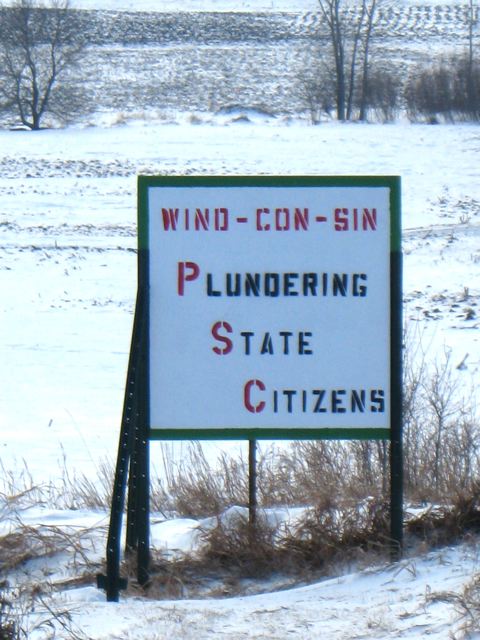 AFTER:
AFTER: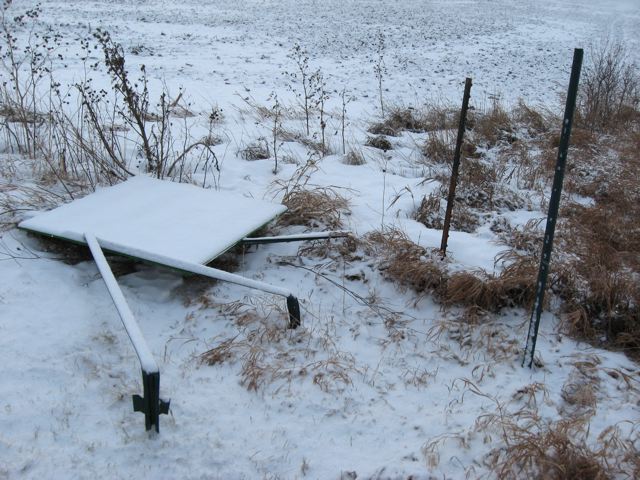
ANOTHER SIGN DESTROYED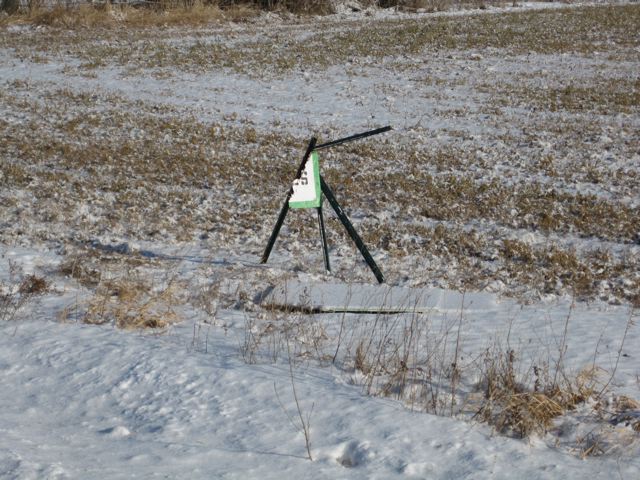
More signs knocked down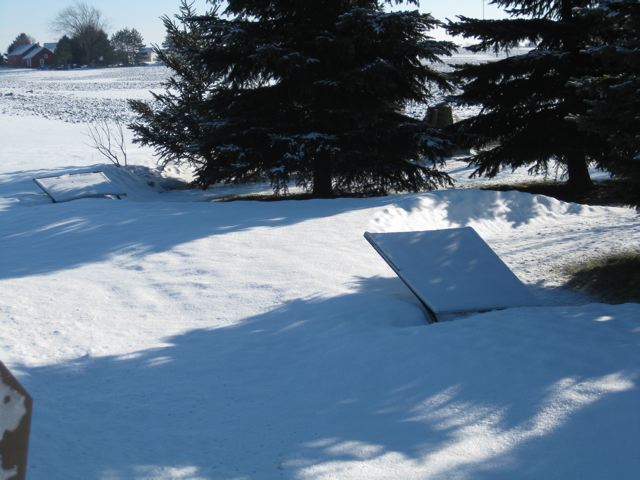
SECOND FEATURE
WIND TURBINE ICE SAFETY NOTICE FROM THE ENBRIDGE ONTARIO RENEWABLE ENERGY OFFICE
POSTED IN: The Shoreline Beacon, www.shorelinebeacon.com
January 4 2011
As with any tall structures, please use caution when approaching wind turbines when potential icing conditions exist. Potential icing conditions can occur at any time during the colder months. Caution should be exercised from November to April inclusive.
The 110 turbine Underwood Wind Farm of EOWP is located in the area two miles north of the Village of Tiverton, just west of Sideroad 30, east of the shores of Lake Huron, and south of the Municipality of Saugeen Shores; and the 5 turbines of Cruickshank Wind Farm are located west of Highway 21 just south of concession 11 in the former Kincardine Township. Please stay well back from each turbine to minimize the potential safety risk due to falling ice. Unauthorized entry to the access roads of the wind turbines is not permitted.
Signage is posted at each wind turbine location.
Contact the Enbridge Ontario Renewable Energy office at 795 Queen Street in Kincardine at 519-396-2440 or 1-877-396-2440 with any concerns.
TODAY'S EXTRA CREDIT QUESTION FROM THE BPWI RESEARCH NERD:
Click here if you'd like to know...
Turbine ice throw: What it is, why it's a problem, and why wind developers continue to insist it's can't happen. Except it has: See video, news reports and pictures.
VIDEOS OF THE DAY
Click on the image below to hear residents of Mars Hill, Maine talk about life with turbines
Click on the image below to see the wind developer's video about the same project
